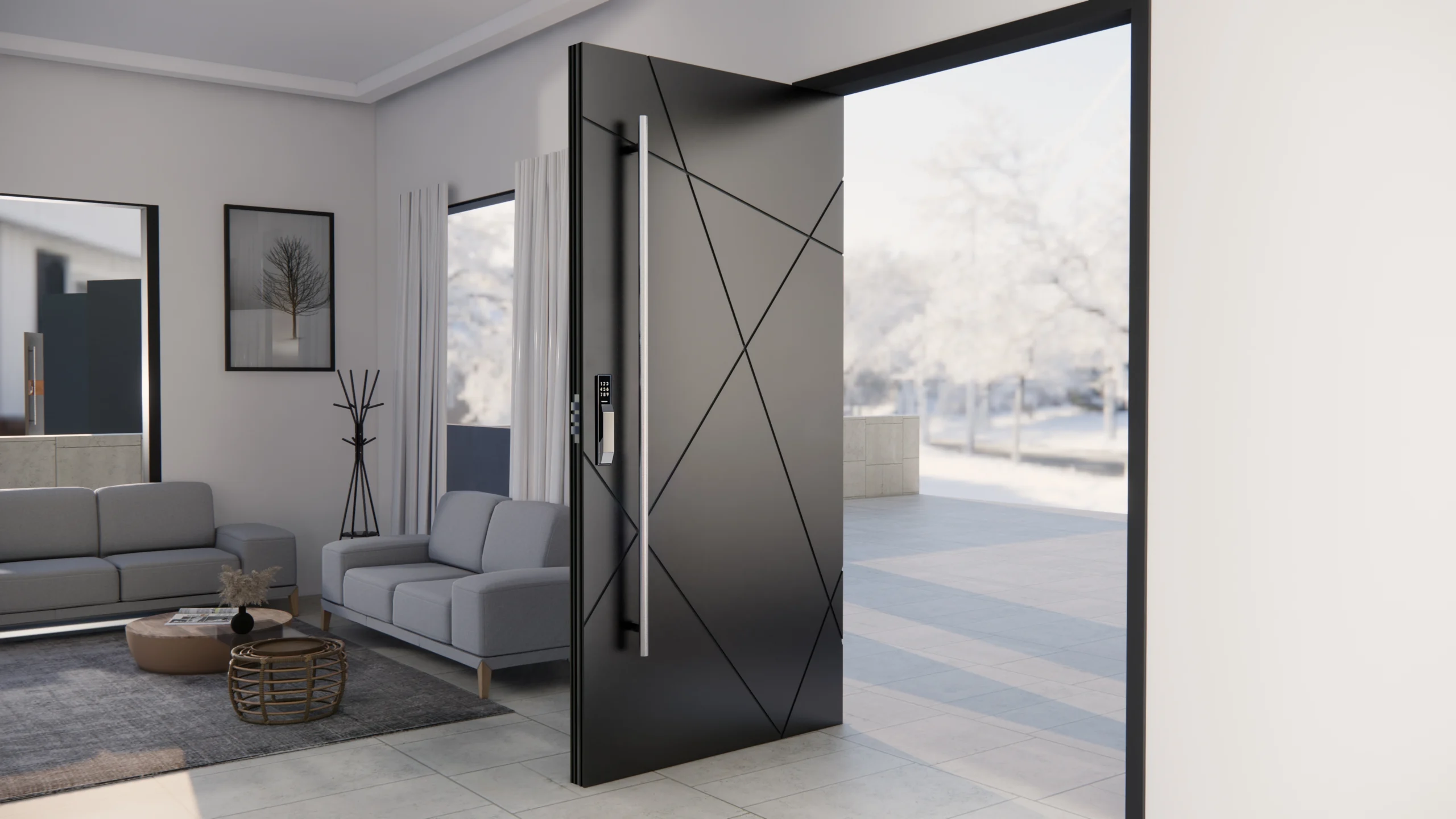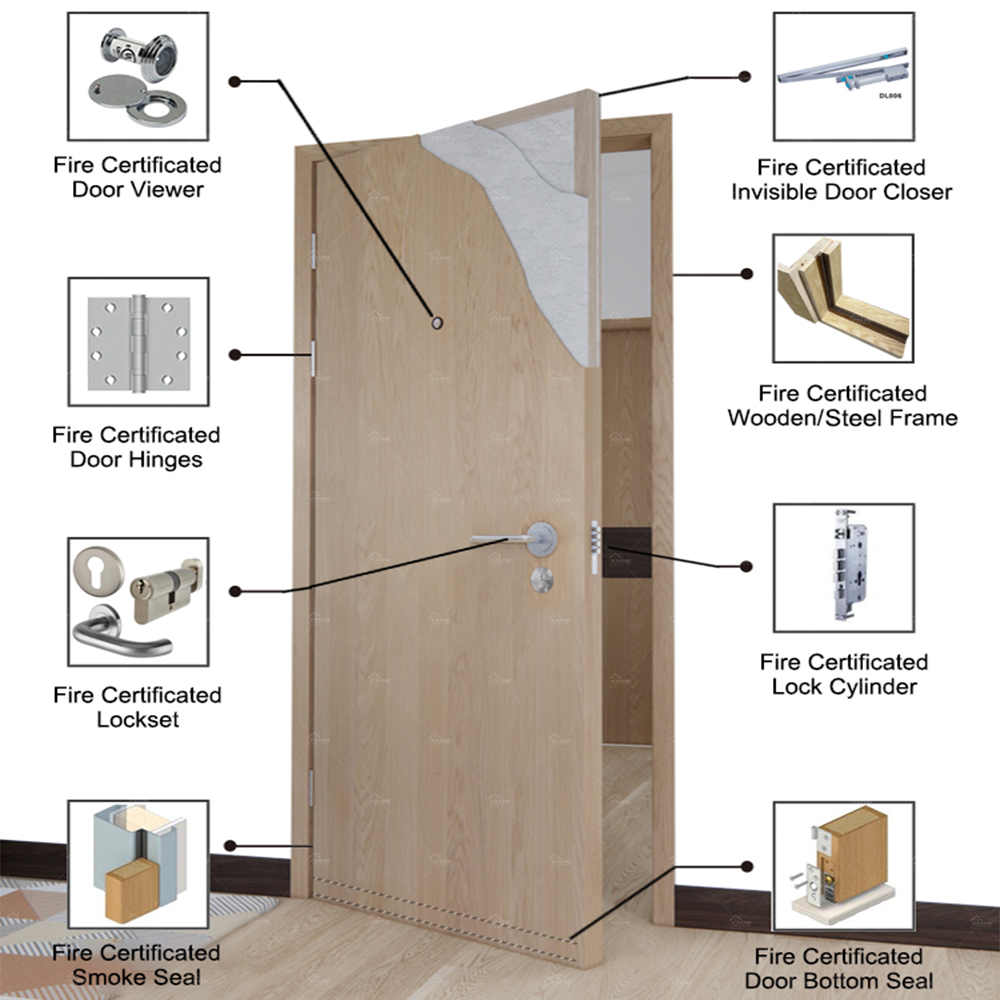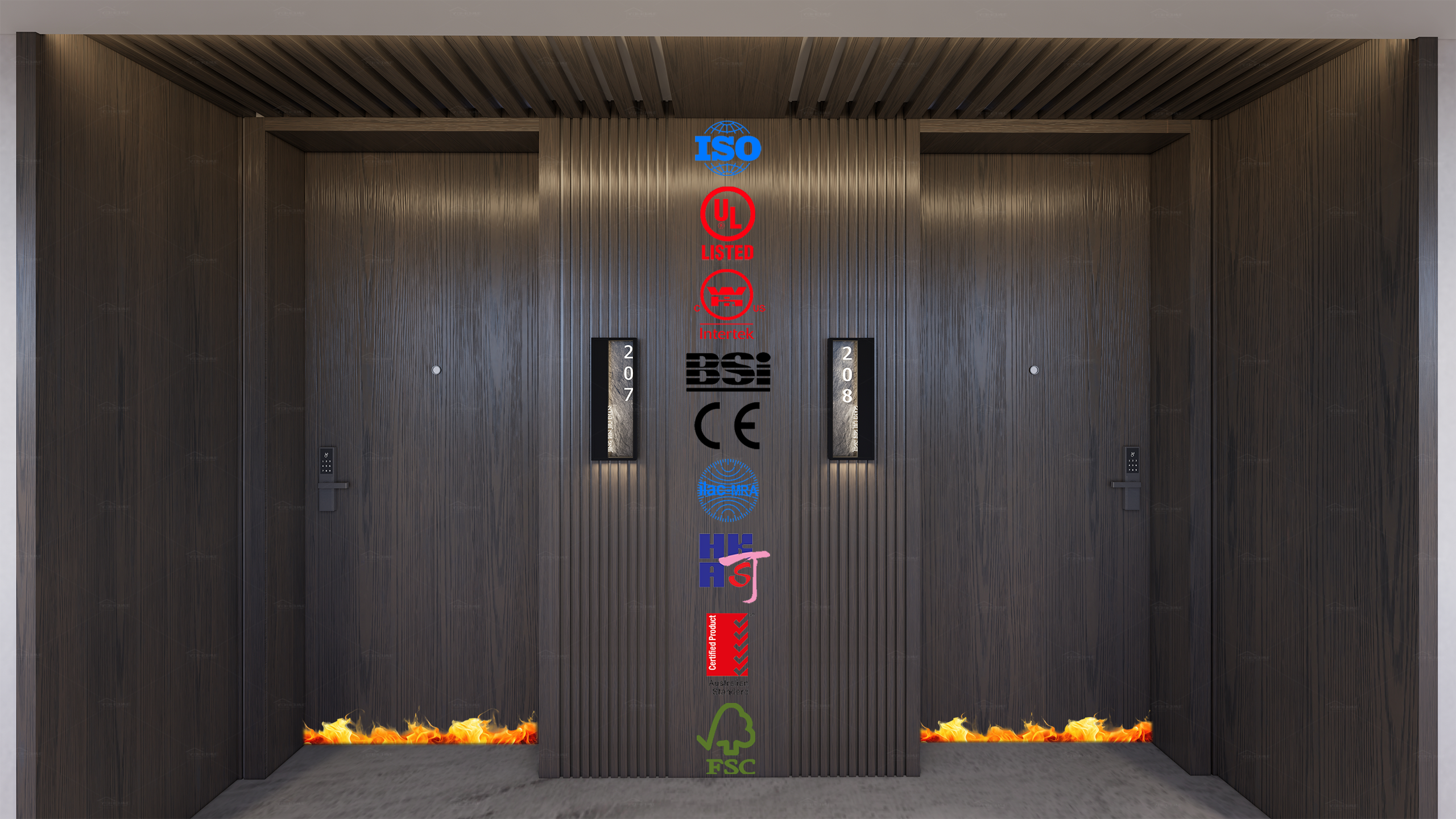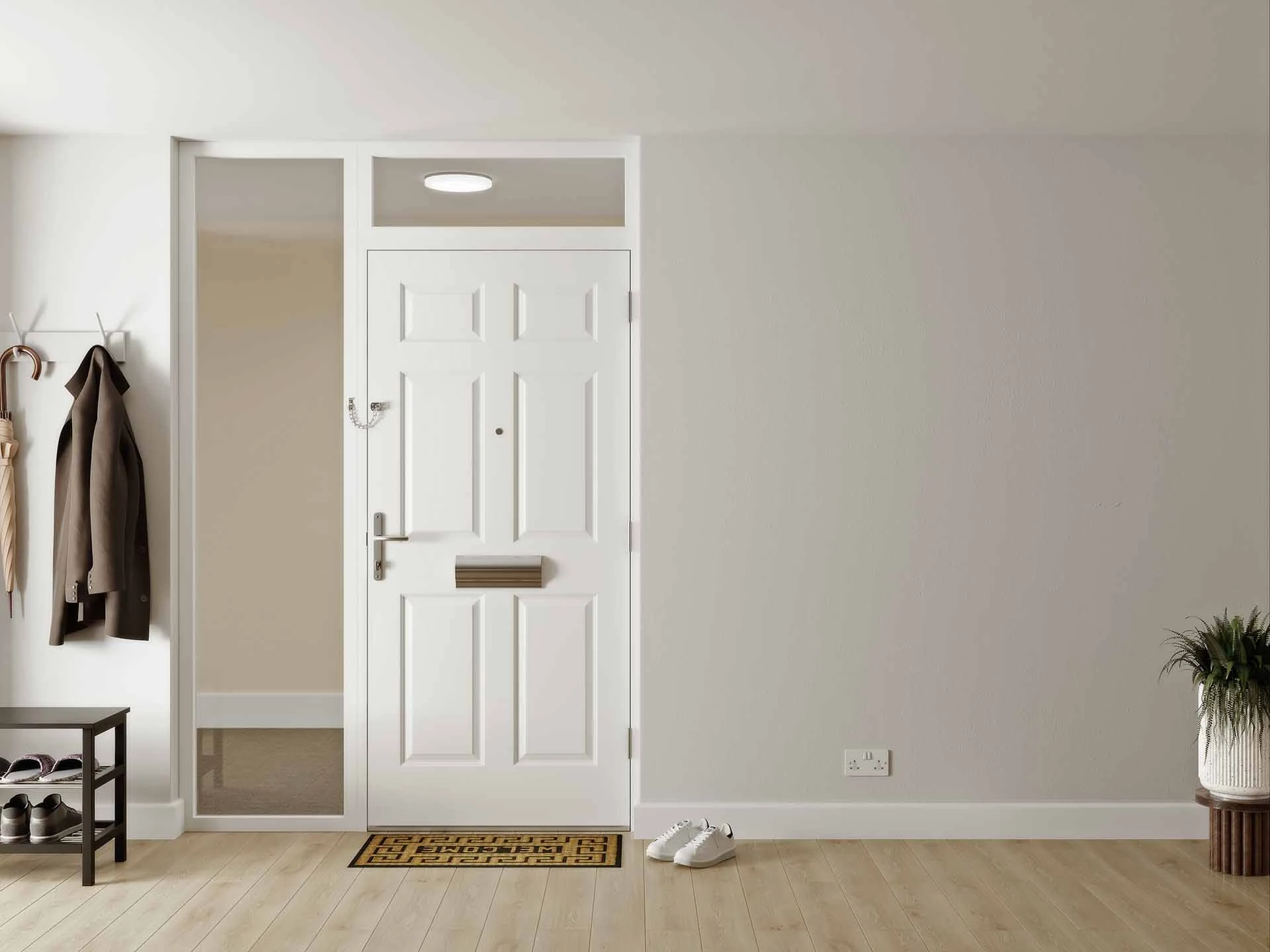Do exterior doors need to be fire rated?

What Does "Fire Rated" Mean for Exterior Doors?
When it comes to exterior doors, many people wonder if fire ratings are something they need to think about. Let’s break down what a fire rated door means and why it matters for safety and compliance.
Understanding Fire Ratings and Safety Standards
Fire ratings are a way to measure how well a door can resist flames and high temperatures. Garages often contain flammable materials, so a fire-rated door can help contain a fire and give residents more time to exit safely.
What is a Fire Rated Door?
Designers and testers have created a fire-rated door to withstand fire for a long time. This doesn’t mean it’s completely fireproof, but it provides a barrier to help slow the spread of fire and smoke. For exterior doors, this can be especially important for areas like garages, basements, or any entrance close to other buildings.
Manufacturers typically make fire rated exterior doors from steel, fiberglass, or fire resistant wood. They often include specific fire seals around the edges to keep smoke and flames from passing too quickly. This added protection can be critical in giving people enough time to exit the building safely or for firefighters to respond effectively.
How Do Fire Ratings Work?
Experts measure fire ratings in time to show how long a door can withstand fire before it starts to break down. Common ratings for exterior doors include 20-minute, 30-minute, 45-minute, 60-minute, and even 90-minute fire ratings. Each number represents how long the door can hold up under intense heat and flames before it starts to fail.
Here’s a quick look at what these ratings mean:
- 20-Minute Fire Rated Door: These doors offer the minimum fire resistance. People often use them in residential settings, particularly for garage doors connected to the house.
- 30-Minute Fire Rated Door: Provides slightly more protection and is more common in areas close to neighbouring structures.
- 45-Minute Fire Rated Door: Offers a solid level of fire protection for various exterior door applications, often seen in commercial spaces or apartment buildings.
- 60-Minute Fire Rated Door: These doors are suitable for areas at higher risk of fire, as they hold up for an entire hour.
- 90-Minute Fire Rated Door: The highest standard, usually reserved for highly regulated or high-risk buildings like hospitals, schools, or industrial facilities.
In summary, fire rated exterior doors serve as a safety measure, giving you peace of mind by protecting against fire. Whether adding a new exterior door to your home or upgrading an existing one, knowing the fire rating can help you make a safer, more informed choice.
Why Fire Rating Matters for Your Home's Exterior Doors
When considering safety and regulations for your home, understanding the importance of fire rated exterior doors can make a significant difference. Let’s look at how fire ratings impact both the safety of your loved ones and compliance with local building codes.
Safety for Family and Property
One of the primary reasons to choose fire rated exterior doors is to enhance your family’s safety and protect your property. Designers create fire rated doors to slow the spread of fire and smoke, giving everyone inside more time to exit safely. In an emergency, every minute counts. A fire rated exterior door can create a crucial barrier, especially in areas like garages, basements, or utility rooms that may be more prone to fires.
Imagine a fire starting in the garage due to faulty wiring or a car issue. With a fire rated door leading to your home, the flames and smoke will have a harder time breaking through, offering more protection and more time for your family to evacuate. Knowing that your exterior doors provide this extra layer of security can bring peace of mind.
Meeting Building Codes and Regulations
Building codes in many areas require fire rated exterior doors in certain home parts, especially between attached garages and living spaces. These regulations exist to protect occupants and reduce fire risks in densely populated neighbourhoods or multi-unit buildings.
Local codes may also specify the type of fire rating needed. For example, regulations might set a 20-minute fire rating as the minimum for a garage door, while they might require a 60-minute rating for commercial or high-risk areas. If you’re renovating or building a new home, checking these regulations ensures you stay compliant, avoid fines, and meet safety standards.
Choosing fire rated exterior doors isn’t just about following the rules—it’s about taking proactive steps to keep your home safe. Whether upgrading doors for a safer home environment or ensuring your doors are up to code, investing in fire rated doors is a smart choice for peace of mind and safety.
Types of Exterior Doors and Their Fire Rating Requirements
Residential Exterior Doors
When picking the right exterior doors for your home, fire rating requirements can be confusing. Let’s investigate whether you need fire rated doors and what materials provide the best fire resistance.

Are Fire Rated Doors Required in Homes?
In most residential settings, the law doesn’t strictly require fire rated exterior doors. However, there are certain areas, like a door connecting an attached garage to the main house, where fire rated doors may be necessary. Local building codes vary, so it’s a good idea to check with your local authority if unsure. Even when laws don’t require them, you can add fire rated doors to your home to provide extra safety, especially if you’re concerned about fire risks from areas like garages, workshops, or basements.
A fire rated exterior door in these spots can help slow the spread of flames and smoke, giving your family more time to exit in an emergency. So, while not always a legal requirement, fire rated doors are worth considering for peace of mind.
Common Materials (Wood, Stainless Steel, Cast Aluminum) and Fire Resistance
Choosing the right material for exterior doors is key to balancing aesthetics, durability, and safety. Here’s how common materials used for residential exterior doors stack up in terms of fire resistance:
- Wooden: Wooden doors are popular for their classic look but are generally less fire resistant than metal doors. However, you can treat some wooden doors with fire-resistant coatings to improve performance. If you want the warmth of wood with extra protection, look for fire rated wood doors that meet fire standards for your area.
- Stainless Steel: Stainless steel doors are highly durable and resist excellent fire. People often use this material in areas that require more protection, like doors between garages and living spaces. Stainless steel doors are also low-maintenance and stand up well to outdoor elements, making them a solid choice for exterior doors where safety and durability are priorities.
- Cast Aluminum: Cast aluminum doors are lightweight yet strong and offer good fire resistance. Aluminum doesn’t burn, making it a safer choice for an exterior door in areas at risk for fire. Designers can also create these doors with a range of finishes, giving you flexibility in style without sacrificing safety.
Each of these materials offers unique benefits, so choosing the best one for your residential exterior door comes down to finding the right mix of style, strength, and fire safety. Whether you’re leaning towards the classic charm of wood or the sturdy protection of steel or aluminum, understanding how each material performs in a fire can help you make a safer choice for your home.
Commercial Exterior Doors
For commercial buildings, choosing exterior doors isn’t just about aesthetics or basic security—it’s also about meeting strict fire safety standards. Let’s explore why fire rated exterior doors are essential in commercial settings and what safety standards they must follow.

Why Commercial Buildings May Require Fire Rated Exterior Doors
In commercial buildings, fire rated exterior doors are often a requirement rather than an option. Unlike residential settings, where safety codes may recommend fire ratings but do not make them mandatory, commercial spaces must follow specific safety codes. The main reason for this is that commercial buildings, such as offices, retail stores, and warehouses, typically house large numbers of people, making it essential to ensure safe exits during emergencies.
Fire rated exterior doors help prevent fire from spreading between different sections of a building or neighbouring buildings. In public spaces like shopping malls or office complexes, these doors protect people and property. Holding back fire and smoke provides extra time for evacuation and emergency services to respond, reducing potential injuries and damage.
Safety Standards for Public Spaces
Fire safety codes for exterior doors in commercial spaces are typically strict, with requirements based on door location, building size, and occupancy type. Organizations like the National Fire Protection Association (NFPA) in the United States set these standards, ensuring that doors in commercial spaces meet minimum safety requirements. For example, NFPA codes often require fire rated doors for exits, stairwells, and passageways leading outside.
In addition to fire ratings, regulations often require commercial exterior doors to self-close and have smoke seals fitted. This means that the doors close automatically to contain the fire within a specific area in a fire. The fire ratings, measured in minutes (such as 60-minute or 90-minute ratings), determine how long the door can withstand fire without breaking down.
Choosing the right exterior doors for a commercial space involves more than just selecting a material or design—it’s about ensuring compliance with local safety standards to protect everyone in the building. Meeting these standards ensures legal compliance and provides a safer environment for employees, customers, and visitors alike.
Fire Rated vs. Non Fire Rated Exterior Doors: What's the Difference?
Choosing between fire rated and non fire rated exterior doors can be a big decision, especially when safety is a priority. Here’s what makes fire rated doors different and how designers design them to offer extra protection.
Key Features of Fire Rated Exterior Doors
Fire rated exterior doors have specific features to withstand high heat and contain fire for a set period. These doors go beyond the standard features of regular doors, focusing on insulation, sealing, and sturdy materials to block flames and smoke.
Insulation and Sealing for Fire Protection
Fire rated exterior doors’ key features are their advanced insulation and tight sealing. These doors often come with special fire resistant seals around the edges, known as intumescent seals, which expand when exposed to high heat. This expansion creates a tight barrier that helps block fire and smoke from passing through.
The insulation within the door also plays a major role. Fire rated doors typically contain materials that resist heat, keeping flames from spreading and reducing the amount of heat that passes through the door. This means that, during a fire, the door’s surface facing the unburned side stays cooler, allowing more time for evacuation.
Reinforced Materials and Construction
Manufacturers reinforce fire rated exterior doors with steel, fire resistant wood, or special fire rated glass. Experts choose these materials for their ability to withstand intense heat and pressure. For example, steel doors can hold up well in fires, as steel doesn’t easily bend or break down under heat. Similarly, doors made from specially treated wood or fire resistant fibreglass offer a strong barrier against flames.
The construction of these doors also sets them apart. Fire rated doors often have a solid or reinforced core construction, making them much heavier and sturdier than non fire rated doors. This added strength is essential in maintaining the door’s integrity during a fire, ensuring it won’t easily warp or break.
Are Non Fire Rated Exterior Doors Less Safe?
Designers design non fire rated exterior doors to offer solid protection from the elements, potential intruders, and daily wear and tear. While they lack specialized features to resist fire, manufacturers still build these doors to be strong, durable, and weather-resistant. A non fire rated door can offer plenty of safety and security for most homes, especially in areas with lower fire risks.
It’s also worth noting that non fire rated doors are often lighter and more affordable than their fire rated counterparts. They come in a wide range of materials, styles, and designs, so homeowners have more flexibility to find a door that fits their budget and aesthetic needs.
Addressing Myths and Misconceptions About Non Fire Rated Doors
There’s a common belief that non fire rated doors are “unsafe” or “low-quality,” but this isn’t necessarily true. Here are a few myths about non fire rated exterior doors and the reality behind them:
- Myth 1: Non Fire Rated Doors Are Not Strong Enough
Manufacturers make many non fire rated doors from durable materials like steel, fiberglass, or reinforced wood. Manufacturers build these doors to resist impact, harsh weather, and forced entry. They may lack fire resistant seals, but they still provide strength and security. - Myth 2: Non Fire Rated Doors Don’t Offer Any Protection
While it’s true that non fire rated doors won’t withstand flames for as long as fire rated ones, they still offer effective protection for many homes. Non fire rated doors provide the same basic function as fire-rated doors to keep your home secure from the outside. - Myth 3: Only Fire Rated Doors Meet Building Codes
Building codes vary, and they often require fire rated exterior doors only in specific cases, such as for doors between a garage and the main house or in certain commercial buildings. Non fire rated doors can still meet local safety and building codes for residential use in other areas.
In summary, while fire rated exterior doors provide extra protection against fire, non fire rated doors aren’t “unsafe.” They’re great for many residential applications, providing security, style, and durability without fire resistance. Understanding the true strengths and limitations of both types of doors helps you make an informed choice for your home or business.

Pros and Cons of Choosing Fire Rated Exterior Doors
Advantages of Fire Rated Exterior Doors
Fire rated options bring specific benefits when considering exterior doors for your home or business. Let’s explore these doors’ advantages in terms of added safety and meeting local building codes.
Added Safety and Peace of Mind
One of the biggest reasons people choose fire rated exterior doors is the added level of safety they provide. Designers create fire rated doors to slow the spread of flames and smoke, giving everyone inside more time to exit safely in the event of a fire. This extra time can be critical for families, especially in homes with children or elderly residents who may need more time to evacuate.
With fire rated exterior doors, you also gain peace of mind knowing that your home has a solid line of defence against fire hazards. Whether it’s a door leading from a garage to the main house or an entryway near areas with high fire risks, these doors can help contain a fire and limit its spread. In an emergency, every second counts, and a fire rated door can buy you that precious extra time.
Compliance with Local Codes
In many places, fire rated exterior doors are a requirement in certain parts of a building, especially in commercial spaces or between a garage and the home. Meeting these local fire safety codes is essential not just for legal reasons but also for the added protection they bring to the building and its occupants.
Compliance with local building codes can also be crucial when it comes to selling or renting a property. Many buyers and tenants prefer homes that meet safety standards, and having fire rated exterior doors in required areas can increase the property’s appeal. Plus, staying up to code can help you avoid inspection fines or complications.
Choosing fire rated exterior doors has clear advantages, from providing extra safety to ensuring compliance with local regulations. These doors are a practical and often essential addition for those looking to protect their property and loved ones.
Potential Drawbacks to Consider
While fire rated exterior doors offer clear safety benefits, there are a few drawbacks to consider before making your decision. Let’s explore some challenges, including higher costs and potential installation issues.
Higher Costs and Possible Installation Challenges
One of the first things many people notice about fire rated exterior doors is their price. These doors are more expensive than non fire rated options due to the specialized materials and construction required to withstand high heat. Each component adds to the cost, from reinforced steel to fire resistant glass and intumescent seals. This means that for some homeowners, the upfront expense of fire rated doors can be a significant investment.
Installation
Another challenge with fire rated doors is installation. Because of their heavy-duty design, these doors are often bulkier and heavier than standard exterior doors. This added weight could complicate installation, sometimes requiring extra labour, special hinges, or reinforced door frames. Modifying the door frame to fit a fire rated door may be necessary for older homes, which can add time and costs to the project.
Additionally, a professional may need to install fire rated exterior doors to ensure they meet local fire safety standards. DIY installation can be tricky with these doors; incorrect installation can impact the door’s fire rating. So, while fire rated doors bring peace of mind, it’s worth considering the extra costs and effort required to install them properly.
When Should You Consider a Fire Rated Exterior Door?
Local Building Codes and Fire Safety Requirements
Choosing the right exterior doors for your home or business often depends on various factors, and local building codes are a big one. Let’s explore why it’s essential to understand your city or state’s fire safety laws and how they impact your decision on fire-rated doors.
Higher Costs and Possible Installation Challenges
In many areas, local building codes dictate when and where to require fire rated exterior doors. These codes vary widely depending on your location, so it’s important to check the specific regulations in your city or state. Authorities put fire safety laws in place to protect property and lives, and they can be especially strict for certain types of buildings, such as multi-family homes, commercial spaces, or structures near other properties.
For example, many local codes require a fire rated door between an attached garage and the main living area. Garages often contain flammable materials, so a fire rated door can help contain a fire and give residents more time to exit safely. In commercial buildings or multi-unit residential buildings, you might also see requirements for fire-rated doors on exit routes, stairwells, or any area that could pose a fire risk to a larger number of people.
Fire Rated Doors for Attached Garages
Certain areas in your home can benefit greatly from fire rated exterior doors, and one of the most common places to install them is between an attached garage and the main living area. Let’s look at why these doors are so important for garage spaces.
Why Garage Doors Often Need Fire Ratings
An attached garage can be a high-risk area when it comes to fire. Garages are often used to store cars, gasoline, paint, and other flammable materials, making them more prone to fires. If a fire does start in the garage, a fire rated exterior door can help prevent it from spreading quickly into the main part of the house.
A fire rated door between the garage and the house is specially built to hold back flames and smoke for a set period—usually at least 20 minutes. This extra time can be vital, giving family members more time to escape safely and allowing firefighters to respond before the fire spreads further. The door’s fire resistant seals and sturdy construction act as a barrier, slowing the spread of heat and smoke.
Building codes require fire rated exterior doors for attached garages in many places to enhance safety. This requirement isn’t just about following the rules; it’s about adding a protective layer to one of the most vulnerable spots in the home. Even if it’s not mandated in your area, having a fire rated door for your garage can give you extra peace of mind, especially if you regularly store flammable items there.
In short, choosing a fire rated exterior door for an attached garage is a smart move to protect your home and loved ones from potential fire hazards. It’s a simple but effective step that could make a big difference in an emergency.
Special Cases: Multi-Unit Buildings and High-Risk Areas
Fire rated exterior doors aren’t always required, but there are specific situations where they can make a big difference in safety. In certain buildings or high-risk areas, these doors offer valuable protection why fire-rated doors are recommended in condos, apartments, and fire-prone zones.
When Condos, Apartments, or Areas Prone to Fire May Need Extra Protection
For multi-unit buildings like condos and apartments, fire rated exterior doors are often a smart choice and, in some cases, a legal requirement. Multiple families or residents in these buildings share the same structure, so any fire can quickly become a major risk. A fire rated door at each unit’s entrance can help contain a fire, preventing it from spreading to neighbouring units and giving everyone in the building more time to evacuate safely.
These doors are especially important in shared hallways and entryways, where a single fire rated exterior door can be a barrier between a unit and common areas. For instance, a fire rated door at the entrance of each apartment unit can keep smoke and flames from quickly entering shared spaces, giving residents more time to reach safety.
Fire rated exterior doors can offer peace of mind in areas prone to fire risks, like regions with dry, hot climates. Homes in wildfire-prone areas may benefit from fire rated doors that add an extra layer of defence, potentially preventing a fire from entering the house or slowing its spread to other parts of the property.
For multi-unit buildings and high-risk areas, choosing fire rated exterior doors is not just about meeting safety codes—it’s a proactive step in protecting lives and property. Whether it’s a high-rise apartment in a busy city or a home in a fire-prone region, these doors provide an added level of safety that can be essential in emergencies.
Can You Upgrade Existing Exterior Doors to Be Fire Rated?
If you already have exterior doors but want to enhance their fire safety features, you might wonder if you can upgrade them to be fire rated. The good news is that while not every door can be converted to meet fire rated standards, there are ways to improve their fire resistance through retrofitting. Let’s explore some effective tips to boost fire safety for your existing doors.

Retrofitting Tips for Improved Fire Safety
- Upgrade Seals: One of the simplest and most effective ways to enhance fire resistance is by adding or upgrading the seals around your exterior doors. Fire-rated doors often have special intumescent seals that expand when exposed to heat. These seals fill gaps and prevent smoke and flames from entering your home. Consider replacing standard weatherstripping with these fire-rated seals for better protection.
- Reinforce the Door Frame: Your door frame plays a crucial role in its overall strength and fire resistance. If your current door frame isn’t sturdy, it may need reinforcement. Installing a new frame that meets fire safety standards can help support the door better during a fire and prevent warping or breaking under heat. A solid wood or metal frame can also provide additional security.
- Consider Fire-Rated Door Hardware: Upgrading the hardware on your exterior doors can also enhance fire safety. Look for fire-rated locks and hinges to withstand heat. This hardware helps ensure the door remains secure during a fire and operates smoothly, even under pressure.
- Install a Fire-Rated Door Cover: If retrofitting your door isn’t feasible, consider using a fire-rated door cover or an exterior door curtain to resist heat and flames. While this isn’t a complete solution, it can offer additional protection, especially for doors in high-risk areas like garages or basements.
- Consult a Professional: If you’re unsure how to retrofit your existing exterior doors, consulting a fire safety expert or a contractor can provide valuable insights. They can assess your current doors and recommend the best upgrades to enhance fire safety without compromising the door’s functionality.
When Replacement is Necessary
While retrofitting existing exterior doors can enhance fire safety, there are times when a complete replacement is the best option. Understanding when it’s necessary to replace a door is crucial for maintaining safety in your home or business. Let’s look at the signs that indicate your door may need to be replaced for fire safety reasons.
Signs Your Door Needs a Full Replacement for Fire Safety
-
Visible Damage or Wear:
One of the first signs that you need to replace your exterior door is visible damage. Look for cracks, dents, or warping in the door material. These issues can compromise the door’s integrity and reduce its ability to resist fire. If the door severely damages, it may not effectively keep flames and smoke at bay. -
Old or Non-Compliant Materials:
If outdated materials that do not meet modern fire safety standards make up your current exterior doors, you need to replace them. Older wood doors, for example, may not provide adequate fire resistance. If your door doesn’t have a fire rating or if flammable materials make it up, you should consider upgrading it. -
Ineffective Seals and Weatherstripping:
Check the seals and weatherstripping around your door. If these components wear out or go missing, they can allow smoke and flames to enter. While you may be able to replace the seals, if the door itself becomes compromised, replacing it entirely is the safest choice. -
Incompatibility with Fire Safety Codes:
If you’re making changes to your home, such as renovations or adding an extension, ensure that your exterior doors comply with local fire safety codes. If your door does not meet these requirements, you may need to replace it to comply with the law and ensure safety. -
Frequent Exposure to High Heat or Fire Risks:
If your door sits in an area frequently exposed to high heat or has a higher risk of fire—such as a garage or near outdoor grills—consider replacing it with a fire-rated option. This ensures you have the proper protection in place. -
Age of the Door:
If your door is old and you have never replaced it, it may be time for an upgrade. Older doors may have lost their effectiveness over time, making them less reliable in the event of a fire.
How to Choose the Right Fire Rated Exterior Door for Your Home
Factors to Consider
When shopping for the best fire rated exterior door, you’ll want to consider a few core factors to ensure it meets all your needs. These elements are not only about enhancing the security of your home but also about complementing its style and staying within budget. Here’s what you need to keep in mind.
Budget, Material, and Style
- Budget: Your budget is the first step in narrowing down your choices. Fire rated exterior doors vary widely in price, depending on material and fire rating level. For example, steel doors are more affordable but may require occasional touch-ups to prevent rust. Wooden doors offer a classic look, but higher fire ratings can increase costs. Consider what you’re willing to spend and weigh it against your desired features.
- Material: The material of your exterior door plays a major role in appearance and fire resistance. Steel and fibreglass are popular for their durability and fire resistant properties. Steel doors are incredibly robust and can withstand high temperatures, making them ideal for fire protection. Fiberglass, on the other hand, is also fire resistant and is great for weather durability, meaning it won’t warp in heat or moisture. Wood offers a traditional, warm look but may need a higher fire rating treatment to provide adequate protection. Choose a material that best fits your climate and lifestyle needs.
- Style: Just because a door is fire rated doesn’t mean it has to look industrial. Exterior doors come in many designs, from sleek modern styles to more classic and decorative looks. You can even find doors with fire rated glass panels, giving you light without sacrificing safety. Match the door style to your home’s architectural look to create a cohesive appearance that’s both safe and stylish.
Working with Professionals for Installation
When you invest in a fire rated exterior door, working with a qualified installer can make all the difference. Professionals understand the specific requirements for exterior doors that meet fire codes. They’ll ensure the door frame is fitted properly, the seals are tight, and the hardware is aligned. This attention to detail creates a secure barrier in case of a fire, giving you valuable extra minutes to protect your home and family.
Ensuring Proper Installation to Meet Fire Safety Standards
- Fire Safety Compliance: A professional installer will ensure your door complies with local fire safety codes. Fire rated exterior doors are designed to withstand high heat, but only when properly installed. This includes using the right hinges, latches, and seals that won’t fail in intense heat.
- Sealing and Insulation: An essential part of fire rated door installation is sealing. Exterior doors should be tightly sealed to prevent smoke and flames from entering. Pros will use materials that resist heat, smoke, and weather conditions, keeping your home fire-safe and energy-efficient.
- Testing and Inspection: Once your exterior door is installed, a final inspection is often done to verify fire safety compliance. Professionals will check that all components are correctly installed and that the door operates smoothly. This final check ensures your door performs as expected, adding peace of mind and long-term protection.
Relate FAQ
Do exterior doors need to be fire rated?
Fire ratings for exterior doors depend on local building codes, the door’s location, and the building’s type. In residential homes, fire rated doors are generally required only between garages and living spaces. However, fire rated exterior doors may be mandatory in commercial buildings or high-risk areas to ensure safety.
What is a fire rated door?
A fire rated door is designed to withstand high temperatures and slow the spread of flames and smoke, providing extra time for safe evacuation. These doors have been tested to meet certain fire resistance standards, commonly rated for 20, 30, 45, 60 or 90 minutes.
Why are fire rated doors important?
Fire rated doors enhance building safety by helping to contain a fire within a specific area, which protects lives and property. They are crucial in places with high fire risk, such as buildings with flammable materials or high-occupancy settings.
How can I tell if a door is fire rated?
Fire rated doors typically have a certification label or stamp on the door frame or edge, specifying the fire resistance rating (e.g., 20, 30, 45, 60, or 90 minutes). This label ensures the door meets specific safety standards.
Are fire rated doors more expensive than regular doors?
Yes, fire rated doors are generally more expensive due to the materials and testing required to meet fire safety standards. However, the added safety benefits can make them a valuable investment, especially in high-risk areas.
Can any door be made fire rated with coatings or treatments?
While fire resistant coatings can improve a door’s ability to withstand heat, they may not bring a non rated door up to full fire-rated standards. Choosing a door specifically manufactured and certified as fire-rated for compliance and safety is always best.
What materials are used in fire rated exterior doors?
Fire rated exterior doors are commonly made from durable, fire resistant materials like steel, fibreglass, or specially treated wood. These materials offer a higher level of protection against fire, helping to meet safety requirements.
Are fire rated exterior doors required in commercial buildings?
Yes, fire rated exterior doors are often required in commercial buildings, particularly where fire risks are higher, such as between garages, kitchens, and storage areas. Local safety codes typically dictate the specific requirements based on building use and location.
What's the difference between fire rated and non fire rated doors?
Fire rated doors are designed to withstand fire for a specific period, slowing the spread of flames and smoke. Non fire rated doors do not have this resistance, although they may still offer protection from weather, impact, and forced entry.
How long do fire rated doors last in a fire?
Fire rated doors are typically rated to last 20 minutes to 3 hours in a fire, depending on their construction and certification. This gives occupants additional time to evacuate and helps contain the fire within a specific area.




